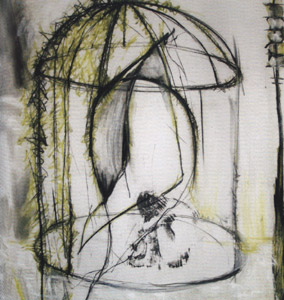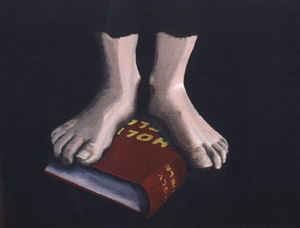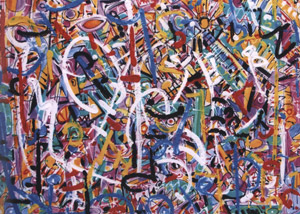
| HOME |
| NERVE |
| REVIEWS |
| ARCHIVE |
| EVENTS |
| LINKS |
| ABOUT US |
| CONTRIBUTORS |
| BACK ISSUES |
| CONTACT US |
 Fis 2008
Fis 2008
Celebration of Irish Culture in Liverpool
Curated by Eamon Colman and Derek Culley
The Novas Centre, Greenland Street, Liverpool
25th July – 7th September
Reviewed by Sandra Gibson
‘Fis’ - Gaelic for ‘Vision’ - is a celebration of the Irish language and culture comprising a series of talks and bilingual films which explore Irish connections with Liverpool and contemporary visual arts by Irish artists from north and south of Ireland including Elizabeth Cope, Fiona Ni Mhaoilir, Geraldine O’Neill, Pauline O’Connell, Anna Marie Quinn, Mary Fitzpatrick, Martin Campbell, Eamon Colman (Aosdana), Derek Culley, David Quinn, Raymond Watson, Rodney Dickson as well as several Irish artists based in Merseyside and abroad.
This review addresses the visual arts component comprising painting, installation and photography.
One would expect any examination of Irish art to reveal certain pre-occupations with Irish themes and this is true of this exhibition though not necessarily in the sense one would presume. There is nothing insular in this work; many of the artists have travelled widely and spent time abroad and this has impacted on their work. The sufferings of the Irish people may be the foundation for expression but the work has something to say far beyond local issues. Anna Marie Quinn’s installation 15 Minutes is a case in point. It invokes a moment in the artist’s life as well as marking the common political experiences of a nation but she has broadened the experience to interact with people from around the world, raising the whole issue of object-attachment. The work comprises 69 blankets and various personal items such as clothing, ritual objects, family photographs, official documents, toys etc. laid out on a dormitory of individual blankets –themselves imbued with political significance in the light of Republican protest in Ulster jails. Having been made homeless during the troubles in Northern Ireland in 1969 when families were told by gunmen that they had 15 minutes to gather their possessions before their home was torched; the artist has used the experience to involve 200 people from around the world in judging the personal preciousness of their own belongings. The resulting installation involves the juxtaposition of items from people who would not normally speak to one another and the artist has stressed the importance of this random element, pinpointing, as it does, the common human experience of flight and refuge and the resonance of certain objects in human lives. Displayed out of domestic context, the objects, no longer belongings, are given an iconic significance whilst at the same time rousing our common interest and sympathies. As well as the expected items one can’t help wondering about the canteen of cutlery and the long, white, debutante gloves.
And are Frank Nightingale’s cremated remains really inside that box?
 Raymond
Watson’s surrealistic installation A Cold Floor similarly draws
on the troubles for its imagery. It comprises a locked steel-barred cage,
a floor of frosted ice created by the use of a condenser unit and a pair
of feet standing on a bible. Dramatically lit so that the shadows of the
bars extend outwards to encompass those outside the cage, and appropriately
curtained off from the other exhibits, it creates a sense of claustrophobic
focus. It references the privations of political prisoners - specifically
those in the Maze Prison - who, having refused to wear prison uniform
took the blanket and were issued with a bible [legally compulsory] which,
whatever its theological uses and sacred status, came in handy for keeping
the feet off the icy stone floor of the cell. It’s a touching image
- with obvious Christian connotations - highlighting the needs of the
flesh as well as the political circumstances giving rise to it and also
our attitude to sacred objects. Raymond Watson’s transformative
paintings of the now derelict Maze Prison comment on the passing of time
in changing physical appearance and use but surely beg the question of
the memories captured in the minds of past inmates. Yet these paintings
contain hope; the artist has set a communal well [based on one he saw
in West Bengal] at the centre of the exercise yard, lowered the prison
walls, shot the locks and filled the sky with golden light.
Raymond
Watson’s surrealistic installation A Cold Floor similarly draws
on the troubles for its imagery. It comprises a locked steel-barred cage,
a floor of frosted ice created by the use of a condenser unit and a pair
of feet standing on a bible. Dramatically lit so that the shadows of the
bars extend outwards to encompass those outside the cage, and appropriately
curtained off from the other exhibits, it creates a sense of claustrophobic
focus. It references the privations of political prisoners - specifically
those in the Maze Prison - who, having refused to wear prison uniform
took the blanket and were issued with a bible [legally compulsory] which,
whatever its theological uses and sacred status, came in handy for keeping
the feet off the icy stone floor of the cell. It’s a touching image
- with obvious Christian connotations - highlighting the needs of the
flesh as well as the political circumstances giving rise to it and also
our attitude to sacred objects. Raymond Watson’s transformative
paintings of the now derelict Maze Prison comment on the passing of time
in changing physical appearance and use but surely beg the question of
the memories captured in the minds of past inmates. Yet these paintings
contain hope; the artist has set a communal well [based on one he saw
in West Bengal] at the centre of the exercise yard, lowered the prison
walls, shot the locks and filled the sky with golden light.
The work of Rodney Dickson has also been influenced by the experience of the troubles in Northern Ireland. He has travelled widely in Vietnam and Cambodia, appalled by war’s futility; fascinated by the places left behind by war. His work Mixed Materials is imbued with a sense of aftermath: bedraggled feathers, faded white fabric flowers, a barely recognizable plastic toy. This rich, beautifully textured and detailed work - having something of the mediaeval miniaturist about it - is characterised by the use of red wax evoking the ritual practices of Far Eastern temples. Wax is an interesting medium. It allows sculptural surface but it is also subject to changing environmental factors. Heat will cause it to melt and distort and transform and one cannot help but think about the effects of napalm on flesh. Where it doesn’t obliterate, the heat of war impairs recognition.
Mary Fitzpatrick uses photography, video and painting to examine the themes of conflict, destruction and memory, creating a personal and historical archive of our times. In her series of twelve photographs: Ramallah, her themes are place – notably left abandoned after conflict - and the effect of time. The residual object, the aftermath of dramatic events, the physicality of stuff are the subjects of her arresting photographs. The end of conflict does not mean that all the causes of danger have been extinguished. Bullets and mines lie on or within the earth where we have our being. These residual things, richly textured, harshly there, of immense interest in light and shadow, in wet and dry reflection, left behind as the result of action and inaction, in decay, still echoing from the past, are still communicating. They lie in and on the earth which will have its gradual effect - corroding, eroding, changing and covering so that they will become part of geological time - a microcosm of which we see in the eroded pages of an Islamic text and the crumpled contours of cloth. In a sense, Mary Fitzpatrick is distancing the terrible events by looking at them from the perspective of time in which all things pass.
Where Mary Fitzpatrick’s examination of place and object has a philosophical point to make about time, Pauline O’Connell addresses the aesthetic topic of the theatricality of object and place; she is working within the still-life genre. The dramatically composed Meat Stall has an eerie quality created by the dark shadows, the shanty-town sense of dereliction and desertion and the subject itself, framed by the use of two diagonals. Accept Only the Best and Large Kanga are beautifully conceived celebrations of the textures and light-reflecting qualities of glass, metal, wood, plastic, brick, slate, the patina of time and use together with ambassadors from the world of commerce: coke bottles, plastic bag with advertising slogan, stencilled letters…
 Derek Culley’s
work can best be described as having a frenetic joy if such a concept
is not a contradiction in terms. Overall the impression is abstract expressionist,
with elements of Rouault though having met this artist I’m sure
he would be unhappy with labelling of any kind. There are recurrent Christian
motifs, such as the fish and the cross and altar vessels, interspersed
with what could be road markings, directional signs, chess pieces, ladders,
both kinds of roundabout, exploding wheels, urban flyovers, eyes, eyes
that may also be fish, flowers, fireworks: colour and form producing a
mesh of brightly coloured and layered textures, added drama created by
the occasional use of black and white. Intricate and meticulous, the painting
has the appearance and energy of something conceived and executed in a
state of urgent single-pointedness: a speeded up experience of time. The
Golgotha pieces could and should be transposed into a series of stained
glass windows. They are spiritual in the sense that a human being has
contemplated the big issues of what the Buddhists would call ‘samsaric
existence’ – the chaotic hurly-burly of life whose roundabout
we long to step off but which attracts us to stay in spite of everything.
Derek Culley’s
work can best be described as having a frenetic joy if such a concept
is not a contradiction in terms. Overall the impression is abstract expressionist,
with elements of Rouault though having met this artist I’m sure
he would be unhappy with labelling of any kind. There are recurrent Christian
motifs, such as the fish and the cross and altar vessels, interspersed
with what could be road markings, directional signs, chess pieces, ladders,
both kinds of roundabout, exploding wheels, urban flyovers, eyes, eyes
that may also be fish, flowers, fireworks: colour and form producing a
mesh of brightly coloured and layered textures, added drama created by
the occasional use of black and white. Intricate and meticulous, the painting
has the appearance and energy of something conceived and executed in a
state of urgent single-pointedness: a speeded up experience of time. The
Golgotha pieces could and should be transposed into a series of stained
glass windows. They are spiritual in the sense that a human being has
contemplated the big issues of what the Buddhists would call ‘samsaric
existence’ – the chaotic hurly-burly of life whose roundabout
we long to step off but which attracts us to stay in spite of everything.
As a counterpoint to these panels – and one feels the decision was deliberate because the exhibition has been so carefully considered – is the work of David Quinn, essentially abstract: delivering the stealthy beauty of tranquillity in the subtle, subdued choice of colour and movement in the restrained textural component.
A similar sense of stillness is found in the art of Martin Campbell which concerns itself with the significance of place and place name. The Irish language has had a strong influence on the work of this landscape artist who combines the historical with the personal and emotional. The trio of paintings: The Cosmos, Teachtairi (Messengers) and Watching the Space Station, Armagh Road are all based in his homeland but as he says, ‘A pretty ordinary place, but in everything ordinary lies the extraordinary.’ These are magical, timeless paintings with something of the Chagall about them combined with an oriental refinement, a sense of minimal and spontaneous effort, a sureness of eye and hand. His two untitled landscapes employ the same spare style, creating a timeless spaciousness.
The landscapes of Eamon Colman also possess serenity, though they are much larger and have a lesser sense of spaciousness. They combine a beautiful, sumptuous colour sense with the mysterious and transient presence of object. There is a lyrical beauty which combines landscape [inner and outer] with abstraction, the floating, fleeting images of mind as well as eye giving a sense of silent mystery and of other worlds commingling and drifting through one another: a ‘palimpsest of confluences.’ These paintings are beautifully composed and executed with sureness and delicacy of touch and an exquisite sense of poise. They pose the question of how the mind remembers places – do images jostle and move and overlap and intensify in emotional colour? It seems they do.
In another masterly decision, the monumental paintings of Elizabeth Cope are placed near those of Eamon Colman as counterpoint. Elizabeth Cope’s work is abrasively shocking, combining as it does the domestic with the brutal, wild movement with areas of bright hot colour: sex, death and hoovering. There is a strong element of black humour in these visceral paintings that address threat and vulnerability. In one painting the earth mother/domestic goddess performs a circus act with a broom whilst manacled by the omnipresent red lobster whose soft parts are protected by shell. In another work, Teats, the figure has twenty breasts encompassing her chest and extending over her head and as far down as her open vagina. Threat exists in the teeth of the hedge cutter and the various items of DIY and the whole mood of hysterical abandonment/lack of control is underpinned by zany diagonal striping.
An additonal curatorial decision has placed three of Elizabeth Cope’s paintings in their own enclave. In Dee with Lobster the pinkness of flesh is clouded by oppression and the teats have lost their brightness in this rather dark portrayal of sexual submission, the lobster squatting on the figure’s back. Skeletons and Lobsters introduces the idea of vanitas and has a decorative picture within as well as the recurrent menacing motifs of scorpion and measuring tape. The most savage painting is full of sexual and competitive violence. A male figure with some skeletal features holds six tennis racquets, creating a frenetic sense of kinesis with balls all over the place. The figure he is grinding into the ground has hold of his blood-red scrotum and all is over-looked by our lobster who is doing a pretty poor job as umpire. These are seriously powerful paintings full of energetic movement and strong imagery whose intensity is alleviated by areas of decorative power within the figurative pieces – more fully explored in her still life works where the influence of Matisse is keenly felt – and her sense of humour.
Geraldine O’Neill is represented by just one piece of work: Superman in which she is raising the question of the viewer’s response to paint on a flat surface. The artist is in playful mode with the mind of the viewer who seeks some kind of significance - symbolic, narrative, allegorical, cultural… from what is seen. At one end of an inaccurately drawn rainbow (?) we have a glossy and strangely inert Superman. At the other end is a naturalistically painted dead bird, both motifs given substance by realistic/illusionist painting and shadowing. The critical mind seeks meaning by trying to find common ground between the two perhaps in terms of contrasts: meticulous realism/comic book style? Reality/fantasy; immortality/mortality? Ability to fly/no longer the ability to fly? And so on in daft pursuit of intellectual satisfaction. The point – on one level - is that ‘Ceci n’est pas une pipe.’
Fiona Ni Mhaoilir’s Imram has a sense of religious drama created by the triptych form, the use of an extremely restricted palette, the traces of ecclesiastical architecture used and the presence of gold. There is a distinct feeling of the artist’s engagement with site and history and religious belief to convey a sense of confinement and potential release. In this her thinking resembles the preoccupations of Raymond Watson.
This is an important exhibition: varied in approach and theme, energy filled, provocative, presented in such a way as to create a sense of spaciousness, of there being room for all ideas present.
Comments:
Comment left by Derek Culley on 9th August, 2008 at 11:17
Rouault is one of my favourite arist's.
Wonderful and thoughtful, a great article.Thank you Derek
Comment left by Eilish on 9th August, 2008 at 17:16
It is good to see that the author knows what their talking about. Excellent article.
Comment left by mary fitzpatrick on 10th August, 2008 at 15:12
I agree..I'm delighted with the article...very thorough and well thought out..
Comment left by John Murtagh on 10th August, 2008 at 21:41
I was fortunate enough to visit the exhibition during a recent visit to Liverpool. Good article gets it just about right